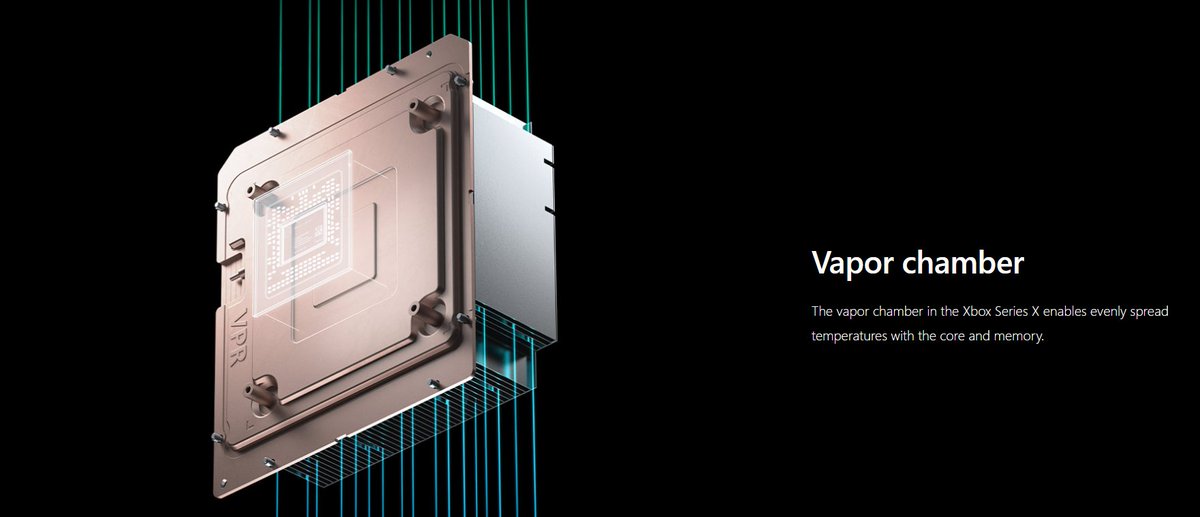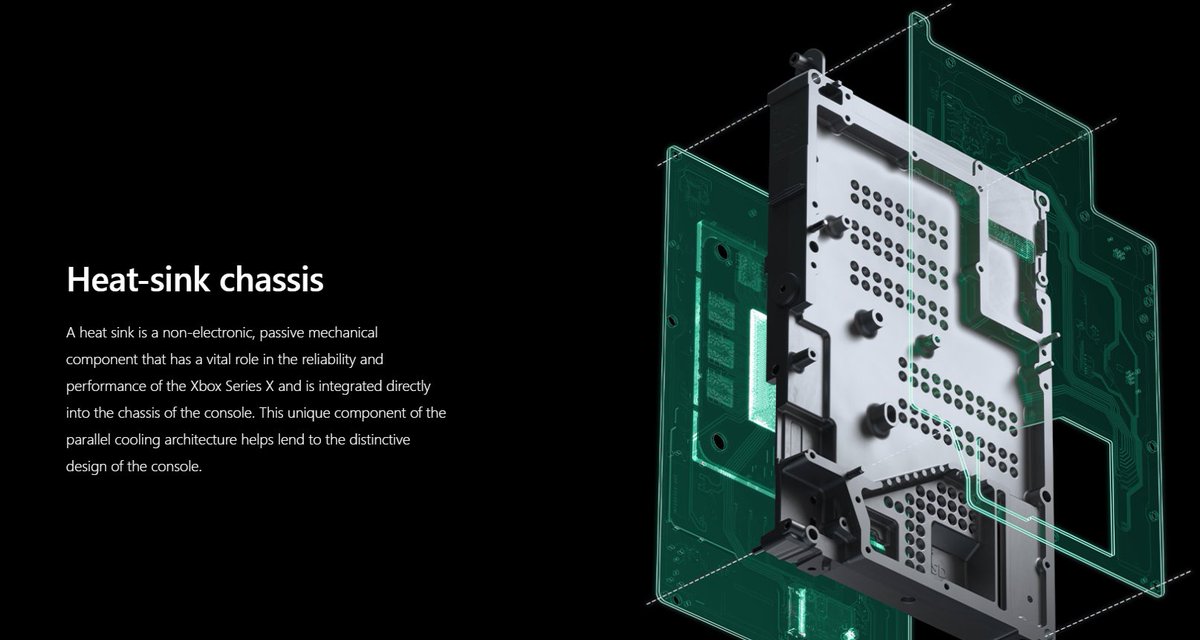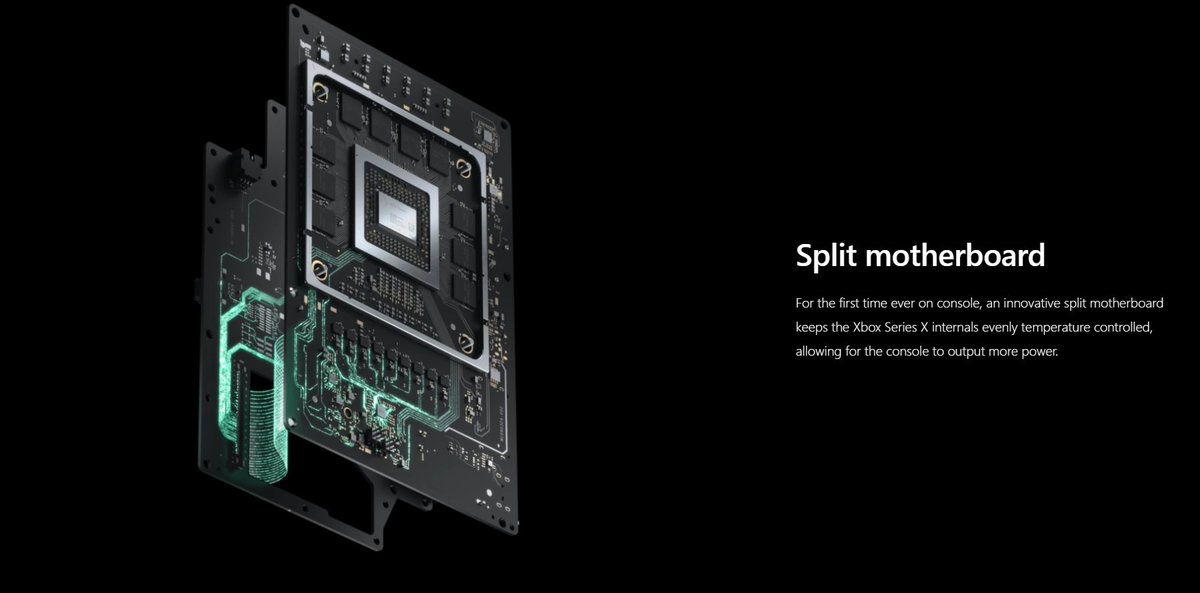1 - Understanding the PS5& #39;s boost clocks as explained in the DF article. The PS5 has a set maximum power budget that it cannot, and will not, exceed ever. Cerny says this is important because in order to cool PS5 they now no longer need to guess what power consumption the..
2 - worst case game might have. Cerny says no PS5 will ever perform differently from another as may occur on mobile phones, tablets or in the case of PC CPUs and GPUs. Something important here I will get back to based on what is said.
3 - Cerny says they don& #39;t use the temperature of the PS5 die as that would lead to two situations where performance could vary between PS5s. One scenario is someone could store their ps5 in a hotter or cooler location, the other is some chips just plain run hotter or cooler.
4 - So their solution, according to Sony was to use an algorithm in which the frequency depends on CPU and GPU activity information. This he says will keep behavior between different PS5& #39;s consistent. This is accomplished via a power control unit constantly measuring..
5 - activity of the cpu, gpu and the memory interface and the tasks they& #39;re performing. Your specific PS5 processor is ignored and instead a general & #39;model SoC& #39; is used, I suppose, of what the ideal PS5 processor should perform like. It& #39;s a simulation of how the processor is..
6 - likely to behave and that same simulation algorithm is applied across every Playstation 5. If you go to the same location in the same game, it doesn& #39;t matter what custom chip you have or what the transistors are like. Whether you put it in a refrigerator or stereo cabinet..
7 - your ps5 will have the same frequencies for cpu and gpu as all other ps5s. So that& #39;s the first part. Developers are able to see exactly how much power is being used by either the CPU or GPU. Cerny says the time it takes the CPU or GPU to achieve a frequency that matches..
8 - their activity is very short. If a game is doing power-intensive processing for a few frames, then it gets throttled. To repeat, if the game is doing power-intensive processing for a few frames, CPU and/or GPU will be throttled. Cerny sees a time where developers begin to..
9 - optimize their game in different ways. Where they try to achieve optimal performance for a given power level. Presumably the only way a developer can do this is if they know what the frequencies are and can optimize for those in particular.
10 - Cerny describes a few scenarios. If you optimize and keep the power the same you see all of the benefit of the optimisation. If you optimise and increase the power then you& #39;re giving a bit of the performance back. Why? Because it means power is leaving either CPU or GPU.
11 - He envisions scenarios where some devs may be able to achieve the same absolute performance but with reduced power. The CPU and GPU each have a power budget, the GPU& #39;s power budget is the larger one of the two. Cerny says that the CPU can be capped at 3.5GHz..
12 - and yet not use all of its power budget, and in such a case the unused portion of the CPU budget can go to the GPU. This is what he says AMD calls "SmartShift." He states there& #39;s enough power that both the CPU and GPU can "potentially" run at their limits of 3.5 & 2.23GHz..
13 - Cernys says it isn& #39;t the case that the developer has to choose to run one of them slower. He describes a specific scenario called "race to idle" where the PS5 GPU for 5 milliseconds out of a 33 millisecond budget is idle. In this scenario for those 5 milliseconds the..
14 - the ps5 power control logic will detect low power is being consumed and decide that the GPU& #39;s clock frequency should be increased. But he describes this as a pointless bump in frequency. Though the clock has increased on the GPU, the GPU now has no work to do.
15 - according to cerny what happens here is the GPU doesn& #39;t do anymore work and instead just processes its assigned work more quickly then is idle for longer, just waiting for v-sync or the like. This was a 30Hz or 30fps scenario that Cerny described.
16 - Cerny says there is an equivalent such "race to idle" scenario on the CPU side where frequencies are just pegged at max when they have no work at all to do. Cerny, though, says this isn& #39;t meaningful in any way and in order to make a more meaningful statement about GPU clock
17 - they would have to locate a location in the game where the GPU is fully utilised for 33.3 milliseconds out of a 33.3 millisecond frame. He goes on to state that when he made the statement that the GPU will spend most of its time at or near (at or near) its top frequency..
18 - that was with "race to idle" taken out of the equation, aka not scenarios where the GPU is not actually doing any work at all. He says they were looking at Playstation 5 games in situations where the whole frame was being used productively. He says the same is true of CPU..
19 - based on situations where it has high utilisation throughout the frame, he says they have concluded that the CPU will spend most of its time at its peak frequency. He& #39;s basically doubling down that with "race to idle" not being a factor the boost clock system should still
20 - see both CPU and GPU while being fully used near to or at peak frequency most of the time. It& #39;s important that Cerny isn& #39;t guaranteeing it will be at peak most of the time, just that it will be near or at peak most of the time. In other words, he is committing to one of two
21 - scenarios - near to the peak frequencies of cpu and gpu or at the peak frequencies of cpu and gpu. What exactly "near to" means is the real question that hasn& #39;t been answered. Is it 100MHz? 200MHz? closer to 300MHz? We don& #39;t know. Continuing soon...
22 - Cerny then goes on to state the obvious: that power consumption and clock speeds don& #39;t have a linear relationship. He states that dropping frequency by 10 percent reduces power consumption by around 27 percent. In general according to cerny, 10 percent power reduction..
23 - is just a few percent reduction in frequency. Let& #39;s assume that the few percent reduction in frequency Mark Cerny is referring to is MAX 5% (let& #39;s assume for the sake of argument the GPU will never go below a 5% reduction from max clock. How many MHz reduction is that? 111.
24 - With that 111MHz (111.5 to be exact) reduction in GPU frequency where does that place the GPU in terms of TFLOPS? It places it at 9.76 TFLOPS. This is for reference because we haven& #39;t been told how far the GPU drops.
25 - Cerny says one of their breakthroughs was finding a set of frequencies where the hotspot, or thermal density of the CPU and GPU are the same. And that& #39;s what they& #39;ve done. Equally easy to cool or difficult to cool. My assumption here is that according to Cerny..
26 - the 3.5GHz of the CPU and the 2.23GHz of the GPU are, in fact, those "hotspots" where both the CPU and GPU in terms of heat production are exactly the same. An assumption because it sounds as if he& #39;s saying that& #39;s how they determined where to "cap" clocks for both CPU & GPU.
27 - on this front, several developers spoke to @digitalfoundry and stated that in their work with the PS5 so far they are throttling back the CPU in order to "ensure" a sustained 2.23GHz clock on the GPU. In other words, developers thus far are finding a "sweet spot"
28 - in which they are able to downclock the PS5 CPU from it& #39;s max possible of 3.5GHz to an as of yet undetermined frequency, and it is at this frequency where they seem to be able to guarantee the PS5 GPU can actually keep it& #39;s very high 2.23GHz clock. What that CPU clock is..
29 - is unknown and we aren& #39;t sure as to how far it needs to be clocked down. But this seems to be developer confirmation that in order to maintain (or better yet guarantee) the PS5 GPU& #39;s max potential performance, the CPU can& #39;t also be running at its max performance.
30 - @digitalfoundry feels this approach makes some sense, and I would tend to agree, that right now most game engines are more tailored to the last gen jaguar cores than these newer zen 2 cores inside ps5 and xbox series x, so even doubling framerate of a title to 60fps..
31 - with current game engines designed as they are, likely still would make the PS5& #39;s zen 2 processor break a sweat. But this introduces a scenario where there will come a time where game engines are no longer designed around jaguar CPUs and are enhanced for Zen 2 CPUs.
32 - One immediately might look at this and say what exactly does this mean for hopes of sustaining the PS5& #39;s 2.23GHz aka 10.28TF GPU performance later into the generation? Is this bad for games? Probably not because there should be plenty of performance to spare.
33 - What I mean is this: the system should have plenty of performance to spare because even if having to work the CPU harder likely means some more of the PS5 power budget needs to go towards a CPU now working harder, which means the GPU& #39;s frequency may have to come down..
34 - it would still lead to games that actually look and play a lot more impressively than the games from earlier in the gen that were likely using the GPU at 2.23GHz or 10.28 TFLOPS.
35 - Or would there be a scenario where developers, instead of lowering the GPU frequency from 2.23GHz, again lower the CPU frequency further once it starts doing more work again with the goal of maintaining the GPU frequency? I believe they& #39;ll opt to downclock the GPU instead.
36 - rather than further continue to lower the CPU& #39;s frequency at the very moment it& #39;s becoming more important to games. This will present next to no issue for PS5 exclusives really. However, it may be in multi-platform titles where this boost setup as is becomes problematic.
37 - Will it work and work well for multi-platforms? Of course it will, but if we are being completely honest it only starts to come apart somewhat when you realize there will be another next gen console that is running a 52 CU GPU at 1.825GHz locked for a consistent 12 TFLOPS
38 - Backed up by a Zen 2 CPU that will either run at 3.8GHz locked in 8 core mode (8 processor threads) or 3.6GHz locked in SMT mode (16 processor threads). I don& #39;t see a realistic scenario where Xbox Series X doesn& #39;t end up showing the hell out in such titles.
39 - more so once the engines start being designed around zen 2 CPUs instead of jaguars. Both companies chose different routes, but I don& #39;t immediately assume Sony really expected Microsoft would be building a system with a GPU at that size and frequency along with a CPU keeping
40 - at such speeds and then would manage to sustain them regardless of what a game is doing or how hard either the CPU or GPU is working. It& #39;s a pretty impressive feat of engineering and how they& #39;re managing to keep Series X cooled while also so whisper quiet.
41 - Just look at this thing. It& #39;s a crazy design for a console.
42 - getting back to the fact that developers told @digitalfoundry they are choosing to downclock the CPU in order to sustain the PS5 GPU& #39;s 2.23GHz clock speed, Cerny acknowledges that the PS5 dev kit does indeed support such locked profiles where, presumably, devs can choose
43 - to run either the CPU or the GPU at a lower frequency for the kind of game they& #39;re designing. With that in mind, Cerny says even when developers choose to do this, PS5 games always get boosted frequencies so that they can take advantage of the additional power.
44 - but keep in mind this is a scenario where developers presumably would be pushing the PS5 as hard as they felt possible already, meaning scenarios in a well optimized PS5 title where the GPU or CPU would actually achieve anywhere near or at peak clocks could either be..
45 - fewer and further in between or more "race to idle" situations as described by Cerny, but it& #39;s anyone& #39;s guess how often the PS5 could maintain peak clocks depending on how hard the developer is already pushing the PS5.
46 - Digital Foundry then attempts to dig a little further to see what the frequencies are like if developers choose to optimize instead to their desired & #39;worst case scenario& #39; frequencies instead of trying to optimize to the ps5& #39;s max power ceiling, which is likely to be what
47 - many devs might choose to do, and what it appears they are doing currently, although there may come a point where they changes, who knows. In other words, Digital Foundry was trying to find out what the low baselines of the PS5 are. Mark Cerny& #39;s answer to this was a odd
48 - in that, clearly seeing where @digitalfoundry was headed with their question, said developers don& #39;t need to optimise in any way for ps5. He says, if necessary, the frequency will adjust to whatever actions the CPU and GPU are performing. From here, Cerny goes further
49 - and seemingly to avoid telling the baseline describes an extreme scenario where code is intentionally written so that every transistor (or the maximum number possible) in the CPU and GPU fip on every cycle. He said games aren& #39;t anywhere near that amount of power consumption.
50 - The issue I have with what& #39;s said here is that isn& #39;t at all the scenario Digital Foundry was trying to inquire about. They were trying to get an idea of what the best minimum clocks that developers could design their games around if they weren& #39;t interested in trying to
51 - perfectly optimize around the power budget with the boost function of the ps5, and instead chase a more consistent and predictable kind of performance for their title, something that tends to be what many console developers prefer. At any rate, Cerny goes on to state
52 - that if such a scenario (a scenario only he himself was suggesting, not digital foundry) were to occur on current gen consoles, the power consumption would be well out of the intended operating range and it& #39;s even possible that the console would go into thermal shutdown.
53 - Cerny ends by stating that PS5 would handle such an unrealistic piece of code more "gracefully." I assume gracefully means carefully throttle throughout to avoid thermal shutdown, bringing us right back to what digital foundry was trying to find out, what is the "safe zone"?
54 - On the Xbox Series X side of things, the scenario Digital Foundry described would equal 100% the same cpu and gpu clock speed baseline figures regardless of how hard the system was being pushed, presumably just consuming more power as the game becomes more demanding.
55 - so that& #39;s what I got from the whole thing about the PS5& #39;s boost clocks. Both consoles take a very different path. My rough assumption is that Sony never anticipated Microsoft would successfully put together a console with as much sustained power as they have

 Read on Twitter
Read on Twitter






